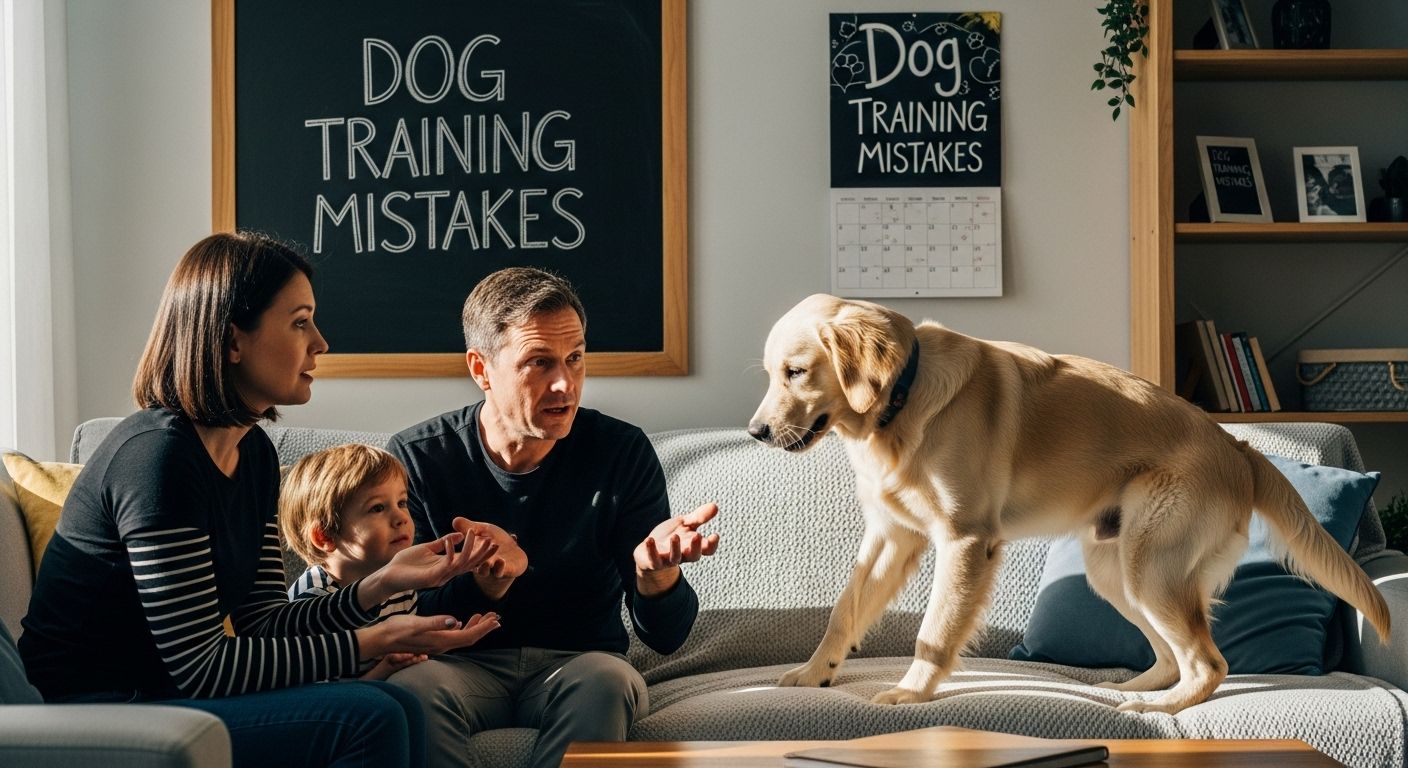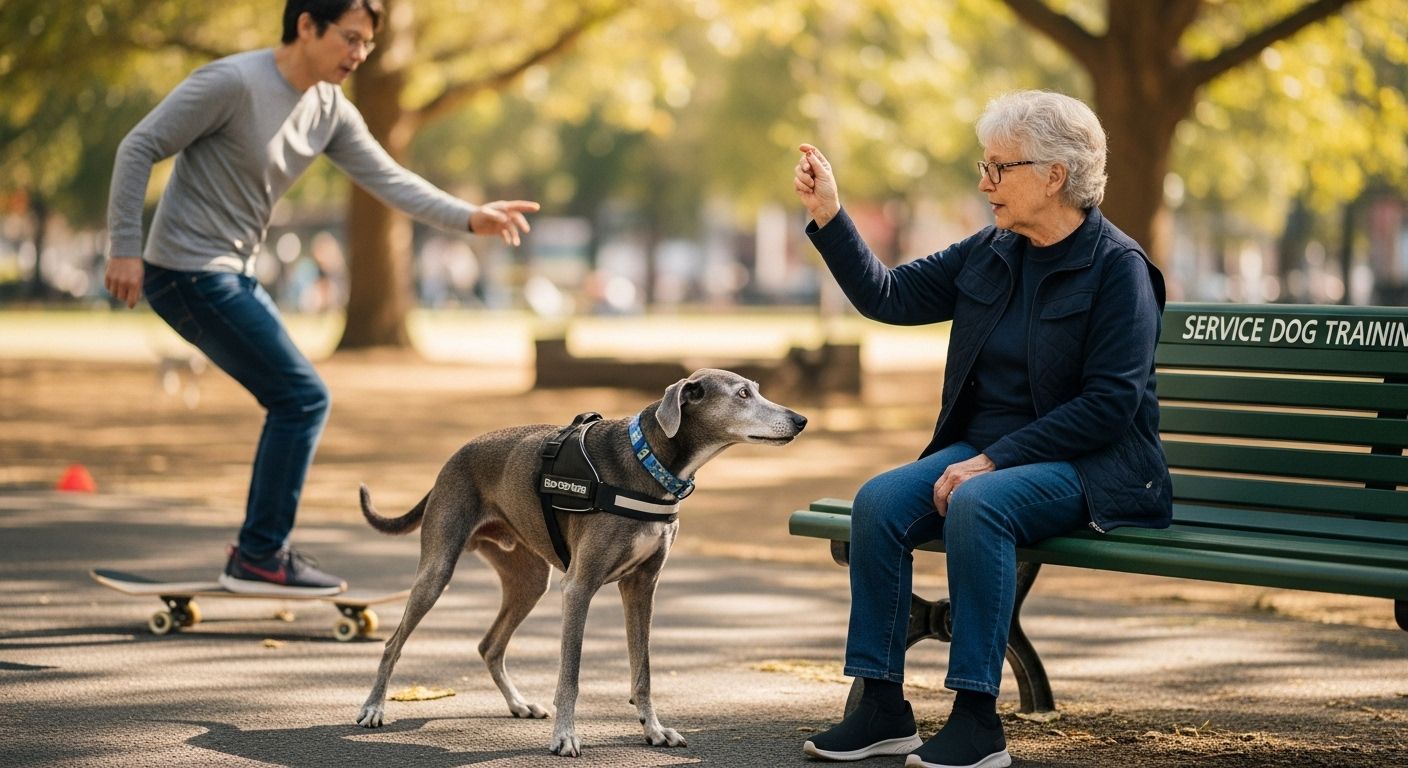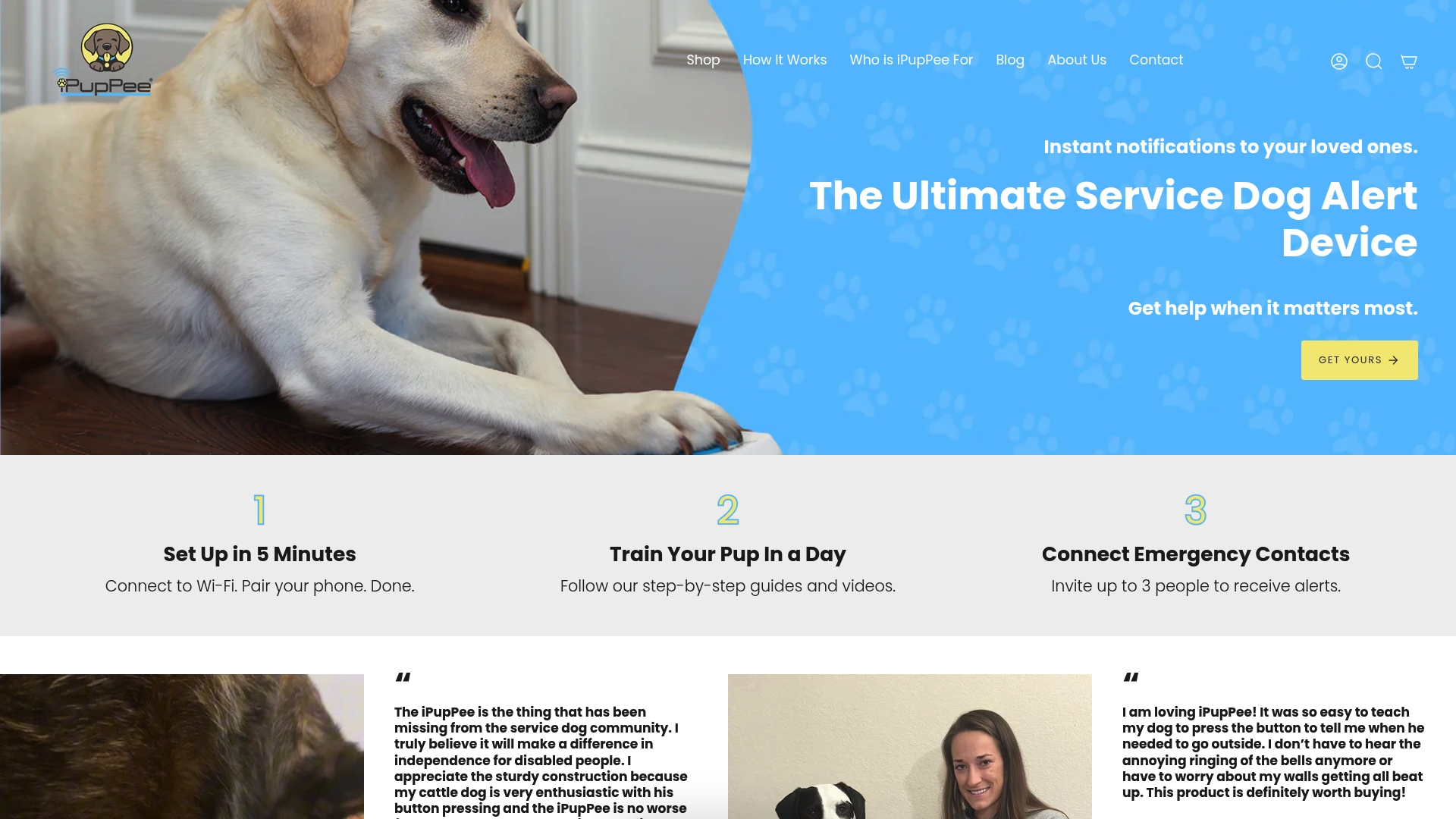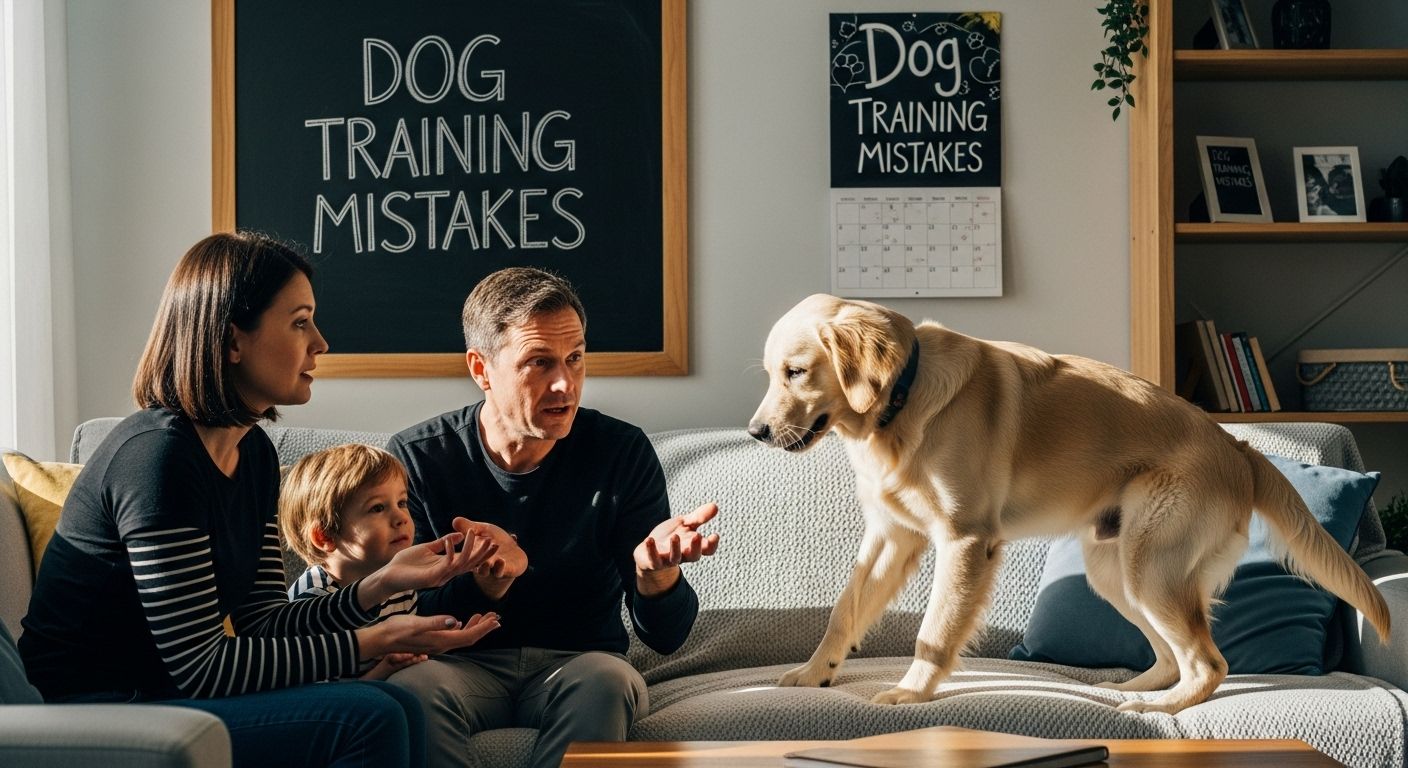
Dog owners want their pets to be happy and well-behaved. Trainers and experts agree that mistakes in training can actually make things worse instead of better. And here is the part that surprises most people. A staggering 93 percent of service dog handlers struggle with training challenges in public settings. Some of the most common mistakes are easy to overlook, yet they can leave even experienced owners scratching their heads. The biggest pitfalls might be simple misunderstandings that nobody talks about—until they cause real issues.
Table of Contents
- Misreading Your Dog’s Body Language
- Inconsistent Rules And Routines
- Incorrect Use Of Rewards And Punishments
- Special Considerations For Seniors And Service Dogs
Quick Summary
| Takeaway | Explanation |
|---|---|
| Understand dog body language | Recognizing signals like tail position and posture prevents miscommunication during training. |
| Maintain consistent training routines | Establishing clear rules and schedules helps dogs understand expectations and builds trust. |
| Use rewards effectively | Immediate and appropriate rewards enhance learning while promoting positive behavior reinforcement. |
| Avoid punishment approaches | Redirecting unwanted behaviors rather than punishing fosters a healthier emotional state in dogs. |
| Adapt training for seniors and service dogs | Tailor methods to accommodate physical and cognitive changes for better communication and training success. |
Misreading Your Dog’s Body Language
Understanding your dog’s body language is crucial for effective training and building a strong relationship. Many dog owners make the critical mistake of misinterpreting their pet’s physical and emotional signals, which can lead to miscommunication and potential behavioral issues.
The Complexity of Canine Communication
Dogs communicate primarily through body language, using a complex system of signals that go far beyond simple tail wagging or barking. Veterinary behaviorists emphasize that each subtle movement carries significant meaning. A tucked tail, for instance, might indicate fear or submission, while a stiff posture could signal potential aggression or discomfort.
Many owners mistakenly believe that a wagging tail always means happiness. However, the tail’s position, speed, and overall body context dramatically change its meaning. A low, slow wag with a tense body can actually indicate anxiety or uncertainty. Research from the Journal of Veterinary Behavior demonstrates that tail movements are nuanced communication signals that require careful interpretation.
Recognizing Stress Signals
To help dog owners easily recognize signs of stress in their pets during training, below is a summary table of common canine stress signals and what they often indicate.
| Stress Signal | What It Means |
|---|---|
| Lip licking | Discomfort, anxiety, or anticipation |
| Excessive yawning | Stress, unease, or confusion |
| Avoiding eye contact | Fear, uncertainty, submission |
| Turning away | Requesting a break, discomfort |
| Low, slow tail wag | Anxiety, uncertainty |
| Tucked tail | Fear, submission |
| Stiff posture | Possible aggression, discomfort |
Stress signals in dogs are often overlooked or misunderstood. Subtle signs like lip licking, excessive yawning, avoiding eye contact, or turning away are not just random behaviors but clear indicators of discomfort. These signals frequently appear during training sessions when a dog feels overwhelmed or anxious.
For example, a dog repeatedly looking away during a training exercise is not being stubborn or disobedient. Instead, this behavior suggests the dog is feeling stressed and needs a break or a different approach. Our guide on recognizing dog alert signals provides deeper insights into understanding these critical communication cues.
Misreading these signals can lead to increased anxiety and potentially aggressive responses. Dogs who feel their warning signs are consistently ignored may escalate to more dramatic communication methods like growling or snapping.
Successful dog training requires developing a nuanced understanding of canine body language. This means learning to read the entire body context, not just isolated signals. Pay attention to ear position, eye contact, muscle tension, and overall posture. Each element provides crucial information about your dog’s emotional state and comfort level.
Practice observing your dog in various situations. Take time to watch how they react during training, playtime, and when encountering new experiences. The more you understand their unique communication style, the more effectively you can respond and support their learning process.
Remember that every dog is an individual with their own personality and communication style. What works for one dog might not work for another. Patience, careful observation, and a willingness to learn are key to developing a strong, communicative relationship with your canine companion.
Inconsistent Rules and Routines
Consistency is the cornerstone of effective dog training. Many pet owners unknowingly sabotage their training efforts by establishing inconsistent rules and routines, creating confusion and frustration for their canine companions.
The Impact of Inconsistent Boundaries
According to the ASPCA, inconsistent rules can significantly undermine a dog’s ability to understand expected behaviors. Imagine telling your dog they cannot sit on the couch one day, then allowing it the next. This mixed messaging creates genuine confusion about acceptable behaviors.
Dogs thrive on predictability and clear expectations. When rules change randomly, they struggle to understand what is truly expected of them. Canine behavior researchers have demonstrated that dogs learn most effectively through consistent, repetitive training approaches that provide clear boundaries and predictable consequences.
Establishing Consistent Training Routines
Successful dog training requires creating and maintaining structured routines. This means establishing consistent feeding times, walking schedules, training sessions, and behavioral expectations. Every family member must agree and follow the same rules to prevent mixed signals.
For instance, if one family member allows jumping while another discourages it, the dog receives conflicting information. Our comprehensive guide on dog communication offers insights into creating unified training strategies that work for entire households.
Consistent routines extend beyond behavioral rules. They include maintaining regular exercise schedules, consistent meal times, and predictable interaction patterns. Dogs feel more secure when they can anticipate daily activities and understand their role within the family structure.
Training sessions should follow a similar consistent approach. Use the same commands, reward systems, and correction methods across all training interactions. This repetition helps dogs understand expectations and builds a clear communication framework.
Practical strategies for maintaining consistency include:
- Creating a written set of household dog rules
- Ensuring all family members understand and follow these rules
- Using identical verbal commands and hand signals
- Maintaining consistent reward and correction techniques
- Scheduling regular training sessions at the same time and location
Remember that consistency does not mean rigidity. As your dog learns and grows, you can gradually modify rules and expectations. The key is to make changes deliberately and communicate them clearly to all family members.
Additionally, consistency helps build trust between you and your dog. When they understand what is expected and can predict your responses, they feel more secure and are more likely to exhibit desired behaviors.
Training a dog is a journey of mutual understanding and communication. By establishing and maintaining consistent rules and routines, you create a supportive environment where your dog can learn, grow, and become a well-adjusted companion.
Incorrect Use of Rewards and Punishments
Rewards and punishments are powerful tools in dog training, but their effectiveness depends entirely on correct application. Many dog owners inadvertently undermine their training efforts by misusing these critical behavioral management techniques.
The Science of Positive Reinforcement
Research from the Journal of Veterinary Behavior demonstrates that positive reinforcement is significantly more effective than punishment-based training methods. Dogs learn best when desired behaviors are rewarded promptly and consistently. However, many owners make crucial mistakes in how they implement rewards.
Timing is everything in reward-based training. A reward must be given immediately after the desired behavior to create a clear connection in the dog’s mind. Delayed rewards confuse dogs and can inadvertently reinforce the wrong behavior. For instance, praising a dog five minutes after they’ve followed a command fails to create the necessary behavioral link.
The type of reward matters equally. Not all dogs are motivated by the same things. Some respond best to food treats, while others prefer verbal praise, physical affection, or play. Understanding your individual dog’s motivation is key to effective reward-based training.

Avoiding Punishment Pitfalls
Below is a comparison table showing common mistakes in using rewards and punishments in dog training, with brief descriptions and their possible effects on your dog’s behavior.
| Training Mistake | Description | Possible Effect on Dog |
|---|---|---|
| Delayed rewards | Reward is given long after desired behavior | Confusion, slow learning |
| Inconsistent rewards | Only sometimes rewarding positive behavior | Unpredictable response |
| Using harsh punishment | Yelling or physical corrections | Fear, anxiety, defensiveness |
| Punishing after the fact | Punishing dog for behavior done minutes ago | No learning, increased stress |
| Inconsistent negative responses | Responding differently to same undesired behaviors | Confusion, insecurity |
Punishment-based training can create significant psychological damage. Canine behavior experts warn that harsh corrections can lead to fear, anxiety, and even aggressive responses. Dogs punished frequently may become withdrawn, less responsive, or develop defensive behaviors.
Common punishment mistakes include:
- Yelling or physical corrections
- Prolonged time-outs
- Inconsistent negative responses
- Punishing after the fact
Instead of punishment, focus on redirecting unwanted behaviors. When a dog exhibits an undesirable action, interrupt and guide them toward the correct behavior. Our guide on balanced dog training provides strategies for creating positive learning environments.
A critical aspect of effective reward systems is gradual reduction of treats. Initially, reward every correct behavior. As the dog learns, slowly decrease treat frequency while maintaining verbal praise and occasional high-value rewards. This prevents treat dependency while maintaining motivation.
Understand that different training stages require different reward approaches. A puppy learning basic commands needs more frequent rewards compared to an adult dog reinforcing established behaviors. Adapt your reward strategy as your dog progresses.
Emotional state matters in training. Dogs are incredibly attuned to human emotions. Rewards given with genuine enthusiasm are more effective than mechanically dispensed treats. Your emotional energy communicates as much as the reward itself.
Remember that training is a relationship-building process. Rewards are not just about behavior modification but about creating a positive, trusting connection between you and your dog. Approach training with patience, consistency, and genuine affection.
Mastering the art of rewards and avoiding punishment requires observation, adaptation, and a deep understanding of your individual dog’s personality and motivations. Each dog is unique, and what works for one may not work for another.
Special Considerations for Seniors and Service Dogs
Training seniors and service dogs requires a nuanced approach that goes beyond traditional dog training methods. These specialized scenarios demand unique strategies, patience, and understanding to ensure effective communication and successful outcomes.
Training Challenges for Senior Dogs
The American Kennel Club emphasizes that ongoing training remains crucial for older dogs. Senior dogs experience physical and cognitive changes that significantly impact their learning capabilities. Arthritis, reduced hearing, and decreased mobility can make traditional training techniques less effective.
Adapting training methods for senior dogs means considering their physical limitations. Shorter, gentler training sessions work best. Use low-impact exercises and reward-based techniques that do not strain their joints or cause unnecessary stress. Focus on mental stimulation through puzzle toys, gentle command reinforcement, and activities that maintain cognitive function.
Specialized Service Dog Training Considerations
Canine Companions research reveals that 93% of service dog handlers encounter challenges with public interactions and dog behavior. Service dogs require extraordinary training that goes beyond basic obedience. They must remain focused, calm, and responsive in diverse and potentially stressful environments.
Our comprehensive guide on service dog support highlights the importance of specialized training techniques. Service dogs must learn to ignore distractions, maintain composure in crowded spaces, and respond immediately to their handler’s needs. This requires a more intricate training approach that combines technical skill with emotional intelligence.
Handlers with cognitive or physical disabilities may face additional training challenges. Research published in the National Center for Biotechnology Information indicates that training consistency can be difficult for handlers with certain impairments. This underscores the need for adaptable, supportive training programs that accommodate diverse handler capabilities.
Key training strategies for service dogs include:
- Extensive socialization in various environments
- Advanced obedience training
- Task-specific skill development
- Emotional regulation techniques
- Stress management protocols
For senior dogs and service dogs, training is not just about commands but about building a deep, trusting relationship. Handlers must approach training with empathy, understanding the unique needs and limitations of their canine companions.
Additionally, ongoing training and assessment are critical. Service dogs and senior dogs require regular health check-ups, skills evaluations, and adaptive training techniques. What works today might need modification tomorrow as the dog’s physical and cognitive abilities change.
Professional guidance can make a significant difference. Specialized trainers who understand the unique requirements of senior dogs and service dogs can provide tailored strategies that address individual needs. They can help handlers develop communication techniques that respect the dog’s capabilities and limitations.
Ultimately, successful training for seniors and service dogs is about patience, adaptability, and understanding. Recognize that each dog is an individual with unique strengths, challenges, and potential. By approaching training with compassion and specialized knowledge, handlers can develop powerful, meaningful partnerships that enhance both human and canine quality of life.

Frequently Asked Questions
What are common mistakes dog owners make in training?
Many dog owners misread their dog’s body language, establish inconsistent rules, misuse rewards and punishments, and fail to adapt training methods for seniors and service dogs.
How can I understand my dog’s body language better?
To better understand your dog’s body language, pay attention to signals such as tail position, posture, and facial expressions. Recognizing signs of stress or discomfort can greatly improve training effectiveness.
Why is consistency important in dog training?
Consistency is crucial because dogs thrive on predictable routines and clear boundaries. Inconsistent rules can lead to confusion about acceptable behaviors, hindering the training process.
How should I use rewards effectively in dog training?
Rewards should be given immediately after the desired behavior to create a clear connection in the dog’s mind. Understanding what motivates your dog, whether it be treats, praise, or play, is key to effective reinforcement.
Transform Your Dog’s Training With Smarter Communication
Are you tired of watching your dog struggle with misunderstandings or inconsistent routines during training? The article highlighted how confusion over body language and missed signals can create stress for both you and your dog. Every pet owner deserves reliable communication, especially when safety and independence are at stake.

Experience the difference with the iPupPee communication device. Our innovative system makes it easy for dogs to let you know what they need, helping you avoid common mistakes like misreading signals or missing important cues. With step-by-step training instructions and real-life testimonials, you can build stronger habits and a happier bond with your dog. Whether you have a service dog, a rescue, or a senior partner, now is the time to provide them a voice. Visit https://ipuppee.com and start your journey toward safer, stress-free training today.
Recommended
-
[
Dog Training Problems: Solutions for Every Owner in 2025
– iPupPee](https://ipuppee.com/blogs/news/dog-training-problems-solutions-for-every-owner)
-
[
Safety Training for Puppies: Essential Guide for All Owners 2025
– iPupPee](https://ipuppee.com/blogs/news/safety-training-for-puppies-essential-guide-2025)
-
[
How to Teach Your Dog Basic Commands in 2025
– iPupPee](https://ipuppee.com/blogs/news/how-to-teach-dogs-basic-commands)
-
[
How to Improve Dog Safety at Home and Outdoors 2025
– iPupPee

